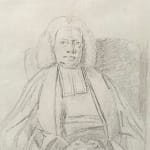Sir Joshua Reynolds PRA FRS FRSA English, 1723-1792
Portrait of Dr John Nicoll
Pencil
Size without frame 7 1/2 x 6 ins
Size with frame 15 x 13 1/4 ins
Size with frame 15 x 13 1/4 ins
£ 5,500.00
Joshua Reynolds was a seminal figure in 18 century English art. Through study of ancient and Italian Renaissance art, and of the work of Rembradnt, Rubens an Van Dyck he brought great variety and dignity to British portraiture.
Reynolds was born at Plympton in Devon, the son of a headmaster and fellow of Balliol College, Oxford: a more educated background than that of most painters. He was apprenticed in 1740 to the fashionable London portraitist Thomas Hudson, who also trained Wright of Derby. He spent 1749-52 abroad, mainly in Italy, and set up practice in London shortly after his return.
He soon established himself as the leading portrait painter, though he was never popular with George III. He was a key figure in the intellectual life of London, and a friend of Dr Johnson. When the Royal Academy was founded in 1768, Reynolds was elected its first President. Although believing that history painting was the noblest work of the painter, he had little opportunity to practise it, and his greatest works are his portraits.
His paintings are not perfectly preserved due to faulty technique. The carmine reds have faded, leaving flesh-tones paler than intended, and the bitumen used in the blacks has tended to crack.
In the first of his famous Discourses, Reynolds stressed the important of drawing from the model in the training of aspiring artists. Students should be encouraged to 'draw exactly from the living models which they have before them', a dictum repeated in his Twelfth Discourse of 15 years later. Despite his urgings, working drawings by Reynolds are extremely scarce; he tended to paint direct to canvas and while the Met and the British Museum possess his sketchbooks it is highly unusual to find study sheets like these. These sketches (see two other entries) could well have been among the lots in the 1821 estate sale of the Marchioness of Thomond, Reynolds's niece and heiress but one can only speculate as the lots were bundled and unnamed. The watermarks here match exactly those found on paper we know Reynolds used; half Britannia with crown and sceptre accompanied by the words PRO PATRIA. The three pencil sketches currently in stock relate directly to finished oil paintings by Reynolds and it is our belief that they form an important part in understanding Joshua Reynolds's working practice.
Reynolds was born at Plympton in Devon, the son of a headmaster and fellow of Balliol College, Oxford: a more educated background than that of most painters. He was apprenticed in 1740 to the fashionable London portraitist Thomas Hudson, who also trained Wright of Derby. He spent 1749-52 abroad, mainly in Italy, and set up practice in London shortly after his return.
He soon established himself as the leading portrait painter, though he was never popular with George III. He was a key figure in the intellectual life of London, and a friend of Dr Johnson. When the Royal Academy was founded in 1768, Reynolds was elected its first President. Although believing that history painting was the noblest work of the painter, he had little opportunity to practise it, and his greatest works are his portraits.
His paintings are not perfectly preserved due to faulty technique. The carmine reds have faded, leaving flesh-tones paler than intended, and the bitumen used in the blacks has tended to crack.
In the first of his famous Discourses, Reynolds stressed the important of drawing from the model in the training of aspiring artists. Students should be encouraged to 'draw exactly from the living models which they have before them', a dictum repeated in his Twelfth Discourse of 15 years later. Despite his urgings, working drawings by Reynolds are extremely scarce; he tended to paint direct to canvas and while the Met and the British Museum possess his sketchbooks it is highly unusual to find study sheets like these. These sketches (see two other entries) could well have been among the lots in the 1821 estate sale of the Marchioness of Thomond, Reynolds's niece and heiress but one can only speculate as the lots were bundled and unnamed. The watermarks here match exactly those found on paper we know Reynolds used; half Britannia with crown and sceptre accompanied by the words PRO PATRIA. The three pencil sketches currently in stock relate directly to finished oil paintings by Reynolds and it is our belief that they form an important part in understanding Joshua Reynolds's working practice.
Join our mailing list
McEwan Gallery Newsletter
* denotes required fields
We will process the personal data you have supplied in accordance with our privacy policy (available on request). You can unsubscribe or change your preferences at any time by clicking the link in our emails.



